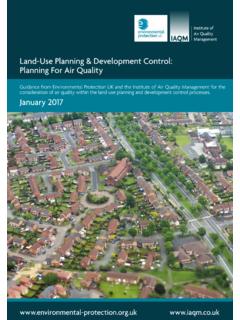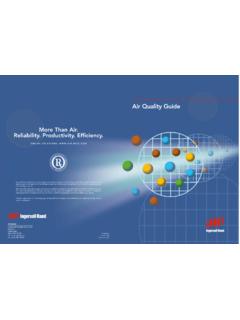Transcription of Air Quality Guidelines - euro.who.int
1 World Health OrganizationRegional Office for EuropeScherfigsvej 8, DK-2100 Copenhagen , DenmarkTel.: +45 39 17 17 17. Fax: +45 39 17 18 18. E-mail: site: 92 890 2192 6 Particulate matter, ozone, nitrogen dioxide and sulfur dioxideGlobal Update 2005 Air Quality Air Quality Guidelines Global Update 2005 GuidelinesThe WHO air Quality Guidelines offer guidance on reducing the effects on health of air pollution. This book presents revised guideline values for the four most common air pollutants particulate matter, ozone, nitrogen dioxide and sulfur dioxide based on a recent review of the accumulated scientific evidence. The rationale for selection of the guideline value is supported by a synthesis of information emerging from research on the health effects of each book gives a brief yet comprehensive review of the issues affecting the application of the Guidelines in risk assessment and policy development.
2 It summarizes information on pollution sources and levels in various parts of the world, on population exposure and characteristics affecting sensitivity to pollution, on methods for quantifying the health burden of air pollution, and on the use of Guidelines in developing air Quality standards and other policy tools. The special case of indoor air pollution is also explored. Prepared by a large team of renowned international experts who considered conditions in various parts of the globe, these Guidelines are applicable throughout the world. They provide reliable guidance for policy-makers everywhere when considering the various options for air Quality Quality GuidelinesGlobal Update 2005 Keywords AIR - standardsAIR POLLUTION - analysisAIR POLLUTANTS - adverse eff ectsAIR POLLUTION, INDOOROZONE - adverse eff ectsNITROGEN DIOXIDE - adverse eff ectsSULFUR DIOXIDE - adverse eff ectsENVIRONMENTAL MONITORINGRISK ASSESSMENTGUIDELINESISBN 92 890 2192 6 Address requests about publications of the WHO Regional Offi ce for Europe to: Publications WHO Regional Offi ce for Europe Scherfi gsvej 8 DK-2100 Copenhagen , DenmarkAlternatively, complete an online request form for documentation, health information, or for per-mission to quote or translate, on the Regional Offi ce web site ( ).
3 World Health Organization 2006 All rights reserved. Th e Regional Offi ce for Europe of the World Health Organization welcomes requests for permission to reproduce or translate its publications, in part or in full. Th e designations employed and the presentation of the material in this publication do not imply the expression of any opinion whatsoever on the part of the World Health Organization concerning the legal status of any country, territory, city or area or of its authorities, or concerning the delimitation of its fron-tiers or boundaries. Where the designation country or area appears in the headings of tables, it covers countries, territories, cities, or areas. Dotted lines on maps represent approximate border lines for which there may not yet be full agreement. Th e mention of specifi c companies or of certain manufacturers products does not imply that they are endorsed or recommended by the World Health Organization in preference to others of a similar na-ture that are not mentioned.
4 Errors and omissions excepted, the names of proprietary products are distin-guished by initial capital letters. Th e World Health Organization does not warrant that the information contained in this publication is complete and correct and shall not be liable for any damages incurred as a result of its use. Th e views expressed by authors or editors do not necessarily represent the decisions or the stated policy of the World Health in Germany by Druckpartner MoserAbstractTh e WHO air Quality Guidelines off er guidance to policy-makers on reducing the eff ects on health of air pollution. Th is book presents revised guideline values for the four most common air pollutants particulate matter, ozone, nitrogen diox-ide and sulfur dioxide. It also gives a comprehensive review of the issues aff ecting the use of the Guidelines , which now apply the world over, in risk assessment and policy matter, ozone, nitrogen dioxide and sulfur dioxideGlobal Update 2005 Air Quality GuidelinesTh is work was supported by grants obtained by WHO from the German Fed-eral Ministry for the Environment, Nature Conservation and Nuclear Safety, the Energy Research Centre of the Netherlands, the Swiss Federal Offi ce for the En-vironment.
5 The Department of Health in the United Kingdom and the United States Environmental Protection VForeword ixIntroduction 1 Development of the update 1 Scope of the update 2 Key scientifi c issues in the development of the Guidelines 4 Th e updated Guidelines and air Quality management 5 References 6 Part 1 | Application of air Quality Guidelines for policy development and risk reduction1. Sources of air pollution 9 Summary 9 Introduction 10 Primary pollutants 12 Secondary pollutants 24 References 292.
6 Global ambient air pollution concentrations and trends 31 Summary 31 Assessment of air Quality based on available monitoring data 32 PM10 or respirable particulate matter 37 Ozone, a regional and global problem 41 Sulfur dioxide, traditionally from the burning of fossil fuel 45 Nitrogen dioxide, a problem related mainly to mobile sources 47 Trends in air Quality 49 References 543. Human exposure to air pollution 61 Summary 61 Defi nition and concept of exposure 62 Where does human exposure occur? 63 Total exposure and time activity patterns 64 ContentsVI Th e infl uence of location on the relationship between sources and exposures 66 Methods of exposure assessment 66 Assessing long-term exposure to air pollution 71 Critical time windows 72 Relationship between personal exposure, indoor concentration and outdoor concentration 72 Key factors determining the relationship between indoor and outdoor concentrations 72 Overall strength of the relationship between personal (or indoor) and outdoor concentrations 76 Population characteristics 77 Impact of exposure measurement error 78 Policy implications of exposure assessment 79 References 814.
7 Health eff ects of air pollution: an overview 87 Summary 87 Introduction 88 What is an adverse eff ect of air pollution? 89 Assessing the health eff ects of air pollution 93 Choice of study design 101 References 1025. Determinants of susceptibility 111 Summary 111 Introduction 112 Who are most aff ected? 113 Chronic diseases as determinants of susceptibility 121 Future considerations 126 References 1266. Environmental equity 135 Summary 135 Introduction to concepts of environmental equity and justice 136 Policy contexts relevant to environmental equity 137 Evidence of inequities in health eff ects of air pollution 139 Evidence on the links between pollution sources and inequity 141 Hot spots, episodes and cumulative impacts 145 Future research and policy implications 146 References 147 VII7.
8 Health impact assessment 153 Summary 153 Introduction 154 Previous studies 155 Inputs for the analysis 156 Benefi ts of conducting impact assessment 161 A simple example of the methodology 164 Uncertainties 166 References 1688. Application of Guidelines in policy formulation 173 Summary 173 Introduction 173 Setting air Quality standards 174 Implementation 182 References 1869. Indoor air Quality 189 Summary 189 Background 190 Characteristics of solid fuel smoke 194 Indoor air pollutant levels in households using solid fuel: concentrations and exposures 194 Health eff ects associated with exposure to solid fuel smoke 197 Comparability of health impacts from indoor and outdoor air pollution 201 Options for interventions 202 Framework for air Quality Guidelines 205 References 207 Part 2 | Risk assessment of selected pollutants 10.
9 Particulate matter 217 Introduction 217 General description 218 Exposures 226 Mechanisms of toxicity 231 Health eff ects 247 Human exposure studies 251 Evaluation 272 Guidelines 275 References 280 AIR Quality GUIDELINESVIII11. Ozone 307 General description 307 Route of exposure and toxicokinetics 311 Summary of the pathogenetic mechanisms of ozone toxicity 313 Health eff ects 314 Guidelines 324 References 32612. Nitrogen dioxide 331 General description 331 Routes of exposure 333 Kinetics and metabolism 333 Health eff ects 333 Evaluation of human health risks 374 Guidelines 375 References 37713.
10 Sulfur dioxide 395 General description 395 Health eff ects 398 Evaluation 411 Guidelines 413 References 415 Part 3 | AnnexesAnnex 1 423 Pathogenesis of ozone-dependent injury 423 Direct oxidation of cellular constituents 423 Induction of respiratory and systemic infl ammation 424 Eff ects on immunity 434 Factors defi ning susceptibility and tolerance to ozone 435 References 458 Annex 2 481 List of Working Group members present at the meeting in Bonn, Germany, 18 20 October 2005 481 List of authors and reviewers not present at the Working Group meeting 483 IXClean air is a basic requirement of human health and well-being. Air pollution, however, continues to pose a signifi cant threat to health worldwide.
















